It’s no secret that acquiring a new customer costs 5x as much as nurturing an existing one. Unfortunately, most brands and marketers end up creating marketing strategies that focus solely on customer acquisition, treating customer retention like the unwanted first slice of every loaf of bread.
A recent study revealed that only 32% of executives believe customer retention is a priority for them. But this shouldn’t be the case. Whether you run a local restaurant, college essay writing service, or physical therapist office, it’s crucial that you create a solid customer retention strategy. If you’re struggling with customer retention, you’ve come to the right place. In this guide, we’ll show you why exactly you need to include customer retention in your marketing strategy and how to use emails to drive it.
Why is Customer Retention Worth Your Time?
If you’re still wondering why you need to focus on customer retention, here are a few solid reasons:
Customer retention increases your chances of clinching a sale
Let’s face it, finding new customers that are interested in purchasing your product takes a lot of effort and resources. You’ll need to expend a lot of energy finding, engaging, and educating these leads on your brand and the needs that your potential customers have that your products solve.
On the other hand, you have a 60-70% chance of securing a sale from an existing customer. This is because they’ve already tried out your product before and know that it’s satisfactory. The only question they’ll probably have to ask themselves is: “Is it worth buying a second time?”
If your product really solved their problems, they should have no hesitation buying from you again. In fact, there’ll be much less need for you to pull up the PowerPoint and distribute flyers to show just how good your product is.
Retention increases referrals
Trying to get new customers through referrals can be as difficult as trying to cut through a frozen burger patty. However, old customers are already familiar with you and therefore much more likely to spread the word to friends and family. Customer referrals can help to boost your referrals and consequently attract new customers to your business.
Did you know that retail customers generally refer to around three of their friends after their first purchase and about seven after their tenth purchase from a satisfactory retail store?
Now imagine what happens if you’re able to retain up to ten loyal customers, and they continue referring every time they purchase. That’s real business!
Why Email Marketing?
Now that you understand the need for a marketing strategy that focuses on customer retention, you’re probably wondering how emails can help you achieve this goal.
The truth is, email marketing is a highly effective strategy for any business. Whether you’re trying to retain an existing customer or looking out for new customers, emails can help you tackle your needs.
Here are some reasons why emails are a great option for driving user retention:
Emails are cost-effective
Let’s take a look at your recent budget and expenses for marketing. How much have you spent so far on paid Facebook or Google ads? Although social media ad campaigns can equally help to drive customer acquisition and retention, using cost-effective methods first can pay off in the long run.
Email marketing is considered one of the least expensive modes of customer communication. For instance, you could spend as little as $19.99 per month to communicate with thousands of customers. Isn’t that a great deal?
This way, you can spend less on customer retention or paid ads and focus on other aspects of your business.
Emails have a personal feel
According to Laura Lopuch, an email conversion engineer and copywriter, emails are the modern version of letter writing. It’s just you and your customer penning down words and promises to each other (more on your part, of course).
When you use emails, you communicate personally with your customers and build a natural, close relationship with them.
E-letters are very easy to use
Email marketing is nothing like rocket science. You don’t need to be a marketing or tech guru to be able to send out automated emails to customers. Once you understand how your email service provider works, you’ll be able to communicate with your audience, increase conversions, and improve customer retention.
Best Practices for Customer Retention Emails
Using email as a vehicle to improve your customer retention is a no-brainer. But how do these types of emails differ from your typical marketing promotions and strategies? While some customers emails may be related to upcoming content or promotions you are running, other types of emails that drive usage, repeat purchases, or adminitstrative needs also take center stage.
To ensure your email marketing is a customer retention driver, here’s a deep dive into some best practices:
Segmentation & personalization are king
Too often customers get inundated with marketing promotions or irrelevant content. This may force customers to unsubscribe from your emails all together and miss out on valuable new products or service updates.
That’s why proper personalization and segmentation is necessary to keep customers happy. According to Forbes, 70% of millennials are frustrated with brands sending irrelevant emails. Use segmentation to ensure you are sending customers down the right email path and only shipping the most relevant content to them.
Clarity and cleverness in subject lines
Great copy moves us to action. And when it comes to the crowded real estate in your customer’s inbox—it pays to stand out. To increase your open rates, it’s important to be eye-catching, but concise. Subject lines should correspond to the content in your email, but be playful enough to grab their attention.
There are a lot of really great tools you can use to test the merit of your subject lines. Our favorite is CoSchedule’s. Simply type in a few different subject lines and it will give you a numeric score with an explanation of what you can improve.
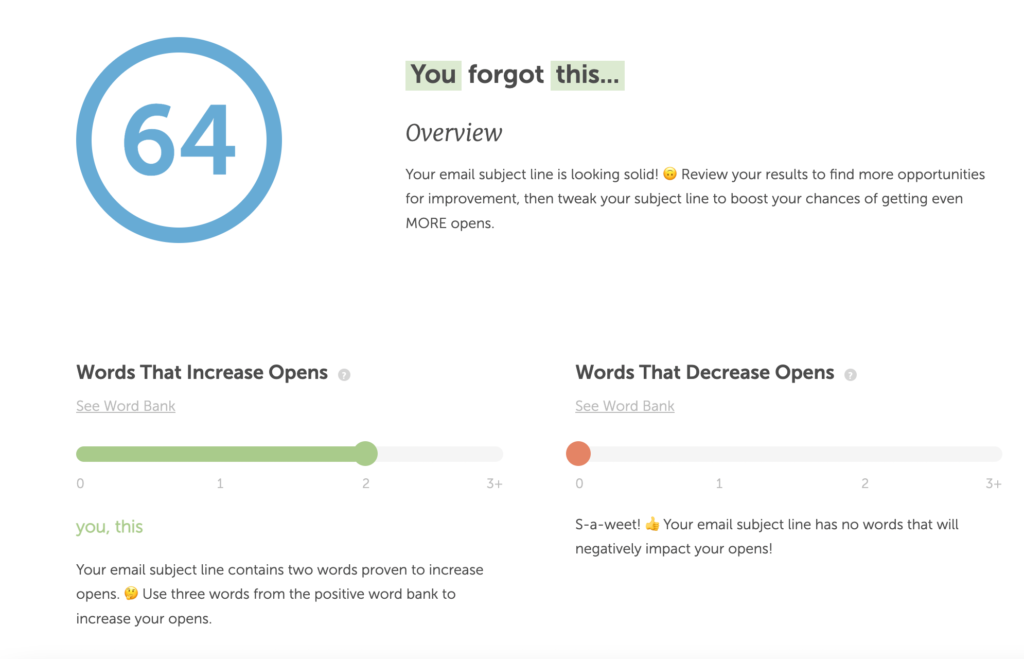
Have a clear CTA & focus
People are rarely going to look past the first few lines of your email. Be sure you state your purpose and have a clear call-to-action (CTA). This email from Airfocus is a great example of a clear cut communication to get a customer to respond with any issues. How can I help get you activated faster?
These type of opened ended questions great for driving engagement with your customers.
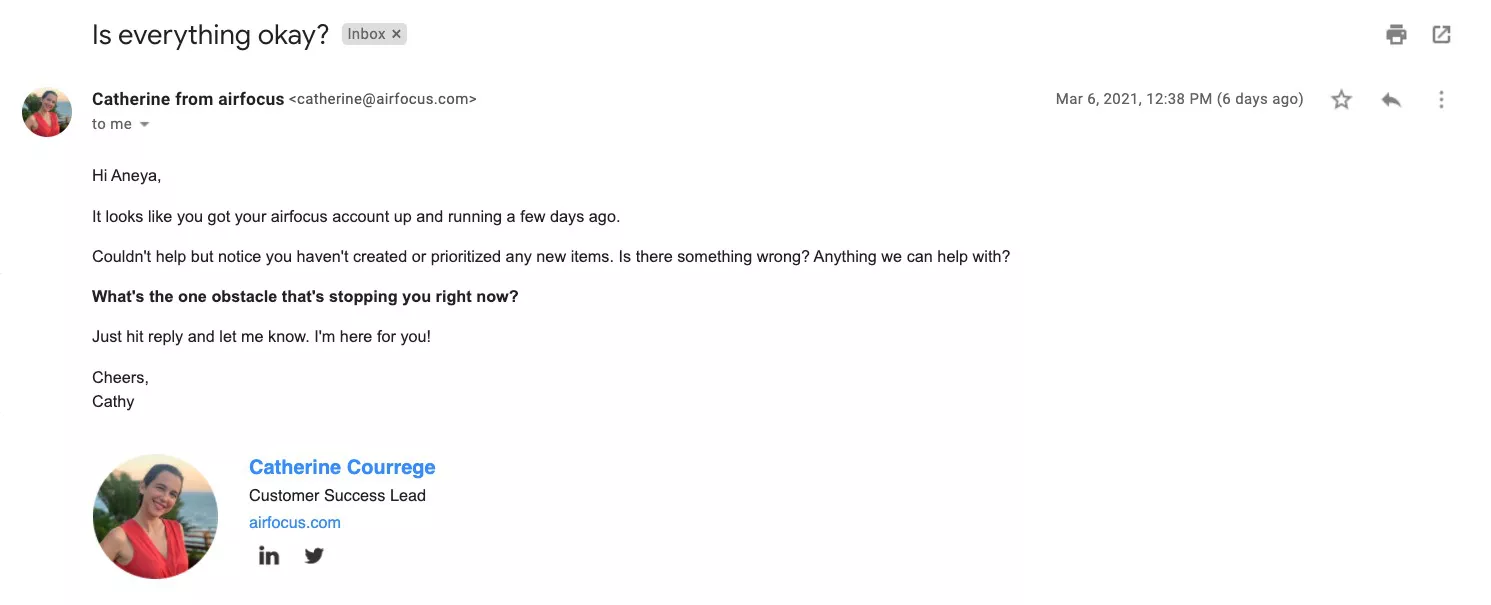
Other popular CTAs could include:
- Add to cart
- Get started now
- Claim your discount
- Read more
Reinforce value
Want to keep customers coming back? Remind them why they chose you in the first place. Depending on your industry there are a couple of ways you can do this:
- Remind them of a product/service they purchased in the past: Whether it’s a favorite shirt they bought or a couple’s massage that brought them closer to a loved one, your company is in the business of creating experienes for customers. Use your email to remind them of this experience, and point them in the direction to seek out that feeling again (i.e., re-purchase). A few examples of this might be a “Based on your past purchases, we thought you might like…” email.
- Make them feel special: Remind customers of the success they’ve had with your products or services! One company that does this really well is Grammarly. Grammarly will send a benchmark email of your writing prowess compared to others:
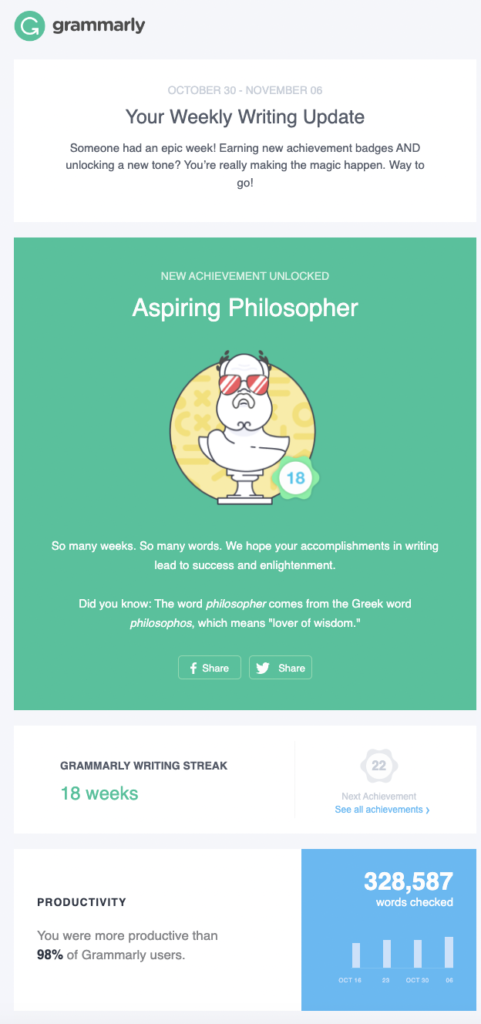
Test & iterate
A good email marketing strategy is not a one-and-done deal. You need to constantly be monitoring how these emails are performing, what emails need to be improved, and experiment with different copy, offers, and subject lines. Let you metrics guide how you iterate and improve these emails over time.
Additionally, take a hard look at attributes like when you send your emails, the audience fit, and the time of day. Small tweaks can make a big impact when it comes to email conversions.
How to Write a Click-Worthy Email Subject Line
You could write the most compelling email in the world—but if your subject line is off, it’s all for nothing.
We’ve already shared a tool that can help you better understand what is and isn’t working with your current subject line. But it always helps to have a baseline. Great email subject lines should have:
- Urgency: Creating a sense of urgency not only provokes customers to respond (and click), but read the contents of your email closely. While many marketers will use this for limited time promotions, when it comes to customer retention emails, the situation might ACTUALLY be urgent—whether that’s renewing a subscription or scheduling an appointment. Your subject line should demonstrate this urgency. For example: Action required: We’re missing some info…
- Offers: If you are sharing a unique promotion or offer with your customers, you don’t have to buy the lede. If you have a compelling offer, why not mention it up-front? For example: LOCALS-ONLY EVENT: Save your spot ✉️
- Intrigue: Sometime the copy is so compelling, you can’t help but click. Creating a sense of intrigue or curiosity is a great way to drive higher open rates with customers. Something as simple as: Don’t miss out on this one 👀
- Personalization: When we talk about personalization, we have to think beyond just a name token. Personalized emails and subject lines, outperform generic templates. Why? Because it shows you care and took the time to understand the customers. Earlier we mentioned that segmentation is a good way to ensure you’re only sending the more relevant emails to customers. Simiarly, segmentation can help you better personalize the subject lines for your email outreach. For example: We saw this, and knew you’d love it
- Relevant/Timely: Keeping up with what’s top-of-mind for customers is key to creating marketing that is relevant and timely. Try to use subject lines that relate to something in current headlines, industry trends, or the time of year. For example: Don’t let snow season slow you down 🚗
7 Customer Retention Emails You Need to Send Out
If you’re gunning for customer retention, you don’t necessarily have to send out dramatic emails that reek of desperation. These simple examples and tips should do the trick:
The welcome email
Picture this scenario: you walk into a small store. The cashier stares at you awkwardly for a few seconds and then gets back to what they were doing. No “hi“, no “hello“, and certainly no “welcome to our store!”
Sounds strange, doesn’t it? That’s exactly what it feels like when you don’t send a welcome email. The welcome email is a valuable part of customer retention that helps to set the tone of your new relationship.
With this email, you’re introducing a customer to your brand and asking them to get comfy. However, there’s more to this type of email than a simple line of text that says “welcome.”
You can also use the welcome email to guide your customers through the process of using your product and incentivize them to take a particular action. For instance, if you run a confectionery website, you could end your welcome email with a CTA button that says: Try out our tasty cinnamon rolls!“
Although many brands have managed to nail the welcome email, we really love Podium’s style. Here’s what it looks like:

Cart recovery emails
We all abandon carts now and then. Maybe the purchase isn’t within your budget right now. Or maybe you’re waiting for pay day before you click that “checkout” button.
According to a Shopify study, about 67.45% of online shopping carts get abandoned before a customer completes the purchase. So how do you stop your customers from abandoning their shopping carts?
While you certainly can’t convince every cart abandoner to check out, you can use recovery email campaigns to lower your cart abandonment rates. Simply ensure that your email contains these crucial elements:
- A creative subject line that will pique customers’ interest and convince them to open the email.
- Persuasive content that demonstrates why the product they were about to buy is a good investment (don’t sound too salesy or else you’ll lose them).
- A clear and powerful CTA to return to their abandoned cart.
Reminder/administrative emails
Reminders and administrative emails are often baseline due diligence, and a clear cut way to improve customer retention at your business. After all, we lead busy lives. It’s easy to forget an upcoming appointment unless a company specifically reaches out. While many local businesses rely on phone communication to keep customers informed, email is another avenue to keep customers up-to-date.
Here’s a good example from a local dentist office.
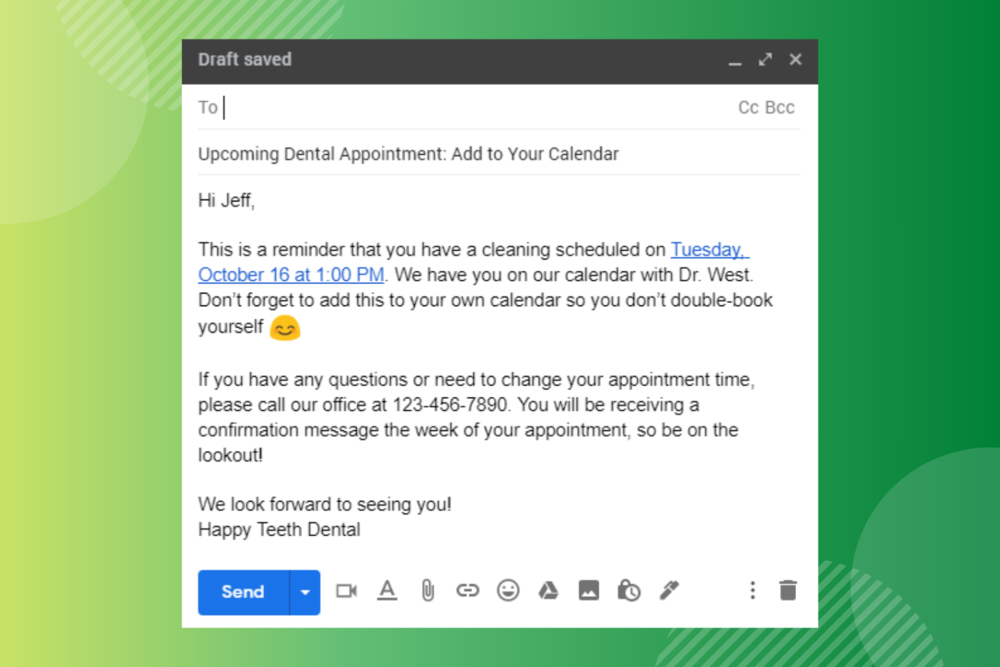
Sequence or lead nurturing emails
Customer retention involves building and nurturing a solid relationship with your customers. But how exactly do you do this?
For starters, you can consistently send out lead nurturing emails. However, remember that you don’t want to spam your audience with too many of them. These emails can be spaced two to three days apart or even a week apart, depending on your specific needs and strategy.
The primary aim of lead nurturing emails is to help your potential customers get to know your brand and products, see their benefits, and be educated about the problems that they solve. While the end goal is to gain revenue from sales, you’ll first have to help your customers solve their problems instead of simply trying to sell your solutions upfront. Depending on the field of your business, many of these nurture emails might contain helpful resources like ebooks that help potential customers solve problems that your ideal customers face every day, and not just directly on your own products.
When you focus on dishing out knowledge instead of focusing too heavily on selling your products or services, customers will begin to regard you as an expert in the field and will run to your brand whenever they encounter a problem.
For instance, let’s go with the confectionery website scenario once again. Your lead nurturing email campaign could include content about common mistakes people make when baking pastries. Does this mean that customers will want to bake homemade pastries instead of buying from you?
Not exactly. They’ll recognize you as an expert who wants to see them win, and the next time they need a glazed, moist buttery birthday cake, who do you think they’re going to call? You.

Special occasion email
Everyone loves birthdays, especially your customers. Sure, you may not be able to show up at their doorsteps with a cake and birthday balloons. However, you can nurture a relationship with them simply by sending an email that acknowledges their birthday.
But don’t just stop at an impersonal “happy birthday“. Go the extra mile by offering them a tiny birthday gift, such as a $10 voucher or 10% discount on their next purchase.
In today’s world, birthday emails may seem overused, but they’re certainly effective, and it’s something your customer will remember for a long time to come. Here’s an example that clear cut from Outdoor Voices:

Not only do we like the simplicity, but the CTA is an easy and convenient method for giving customers value.
Re-engaging emails
When it comes to email retention strategies, there’s something known as re-engaging emails. This type of email is targeted at dormant subscribers who may have stopped interacting with your brand a long time ago.
Instead of letting them lie dormant, you can win their hearts (and interest) back by sending them a re-engaging email. For instance, you could send them a “Yo-hoo, I’m back!” email. This works just like a second welcome mail, reminding them of your brand and what you do.
You can also make these sleepy subscribers a special offer to re-ignite their interest and get them to patronize your brand again.
However, if there’s still no response to your re-engaging email, you may have to take a step back and remove them from your subscribers’ list.
Promotional emails
We could write another 5,000 words on amazing promotional emails from around the web, but when it comes to your customers it’s important to give them a unique experience. Something relevant and easily accessible to them. Starbucks does a great job of this during the holidays, enticing reward members with exclusive emails, like the ones below to drive them back to the store.

Customer Retention Email FAQ: A Quick Recap
What is an example of customer retention?
Customer retention looks at customer loyalty over time. Repeat purchases are the ultimate goal of a high-performing customer retention strategy. Repeat customers:
- Know your business
- Know your products/services
- And in some cases, know what they want right away
With that in mind, you cannot build an acquisition strategy for repeat customers in the same way you would with new customers. Just the same, you cannot build an email marketing strategy that isn’t unique to current customers.
How do you retain customers?
There are many different ways to retain customers, but a great customer experience, competitive pricing, and a hard-hitting customer engagement strategy are the bedrock. For more information on developing a best-in-class customer retention strategy, check out our guide.
What makes a good customer retention email strategy?
Creating a personalized customer experience that is convenient will almost always spell success for your business. Ensure your email marketing strategy lives up to some of the best practices we’ve mentioned through out this guide:
- Segment and personalize your customer outreach and nurtures
- Use concise and intriguing subject lines to drive open rates
- Have a clear CTA and focus for your emails
- Reinforce the value you provide and continue providing more value with each communication
- Test and experiment with copy, subject lines, offers, time sent, images, and more.
Can you win back old customers through email?
Of couse! Win-back programs work, and email can be an important vehicle for driving engagement with previous customers. Win-back emails are a type of “re-engagement” email to entice customers to:
- Resubscribe
- Repurchase
- Or re-engage
There are a lot of examples from brands that do this well. Sephora does a good job at this by offering an exclusive discount to disengaged customers:
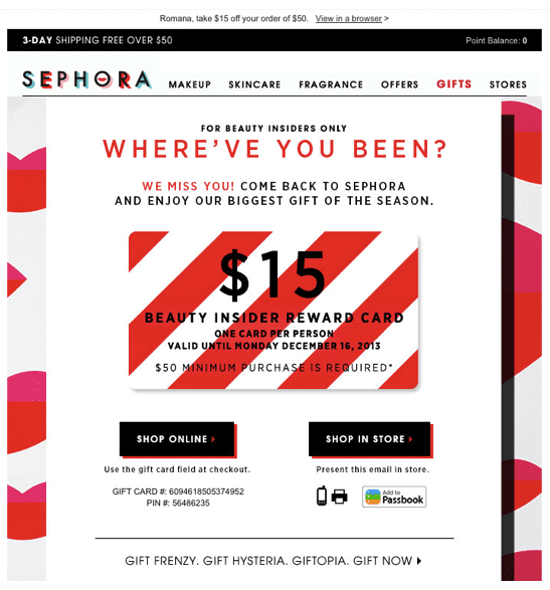
How long should you wait before re-engaging churned customers through email?
The answer here really depends on the nature of your business and if the customer has taken any actions with your brand. For example, have they still been opening your emails or browsing your website? Or have they fallen off completely? Intent signals should be a trigger for re-engaging with customers. Otherwise, a 3-6 month window is best to ensure you do not irritate your customers.
Final thoughts
Now that you’ve gotten the hang of retention emails and how to send them, it’s time to actually put in the work. Start by sending a welcome or activation mail to kickstart your relationship with the customer. As time goes on, you can then work your way towards more personalized emails.
Good luck!




